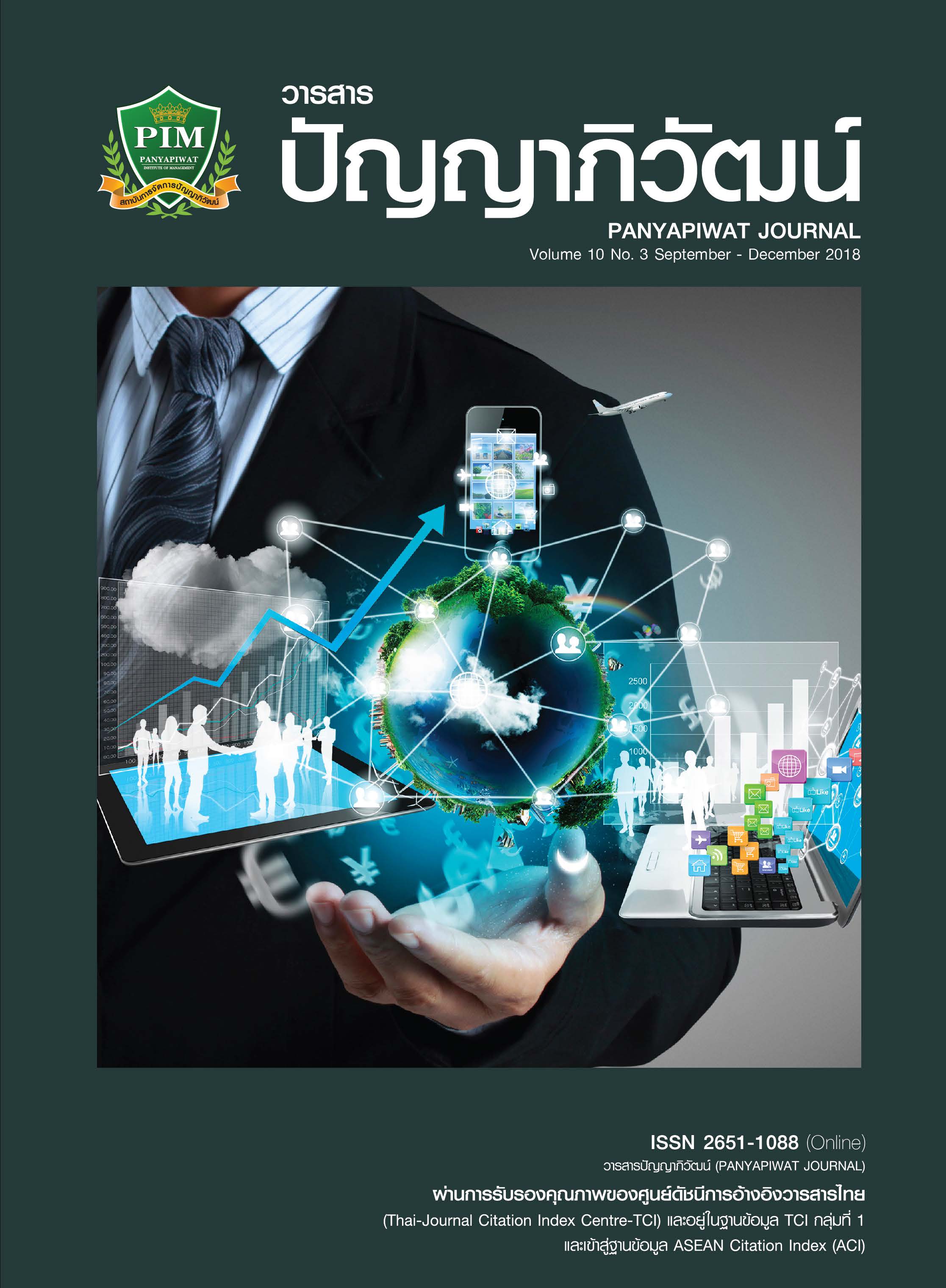THE RELATIONSHIP BETWEEN SMALL GROCERY STORE IMAGE AND CONSUMER PURCHASING BEHAVIOR: A COMPARATIVE STUDY OF TRADITIONAL TRADE AND MODERN TRADE IN THAILAND
Main Article Content
Abstract
This research Objectives were (1) to study the behavior of purchasing from traditional trade and modern trade of Thai consumers in Bangkok and other parts of Thailand, (2) to compare the image of small grocery stores in the consumers’ point of view between traditional trade and modern trade, and (3) to study the relationship between the image of the small grocery store and the consumer purchasing behavior in each product category. This is a mixed methodology research using qualitative research through in-depth interview 15 consumers who have purchased consumer products from small grocery store both traditional trade and modern trade. Quantitative research was conducted by using questionnaires to ask 839 consumers who have purchased consumer goods from both store types. The descriptive statistics were used and analyzed the relationships between traditional and modern retailers in Thailand and their purchasing behaviors with Structural equation modeling (SEM). The results revealed that the relationship of the retail store image in each type affected the consumer purchasing behavior. The traditional trade image direct effect size was 0.531 at 0.01 level of significance,while the image of modern trade had affected products purchasing as well by the direct effect size was 0.445, at 0.01 level of significance.
Article Details
I and co-author(s) certify that articles of this proposal had not yet been published and is not in the process of publication in journals or other published sources. I and co-author accept the rules of the manuscript consideration. Both agree that the editors have the right to consider and make recommendations to the appropriate source. With this rights offering articles that have been published to Panyapiwat Institute of Management. If there is a claim of copyright infringement on the part of the text or graphics that appear in the article. I and co-author(s) agree on sole responsibility.
References
Abrudan, I., Plaias, I. & Dabija, D. (2015). The relationship among image, satisfaction and loyaltyinnovative factor of competitiveness for shopping centers. Amfteatru Economic, 17(39), 536-552.
Chang, E. C. & Luan, B. (2010). Chinese consumers’ perception of hypermarket store image. Asia Pacifc Journal of Marketing and Logistics, 22(4), 512-527.
Cronbach, L. J. (1990). Essentials of Psychology Testing (5th ed.). NY: Harper.
Department of Business Development. (2017). Retail Store Management Guidebook. Retrieved December 18, 2017, from https://www.dbd.go.th [in Thai]
Hsu, M. K., Huang, Y. & Scott, S. (2010). Grocery store image, travel distance, satisfaction and behavioral intentions: Evidence from a Midwest college town. International Journal of Retail & Distribution Management, 38(2), 115-132.
Jantawatcharakorn, J. (2016). Factors Influenced a Decision Making to buy Ready to Eat in Convenience Store of Consumers in Bangkok. Panyapiwat Journal, 8(1), 39-45. [in Thai]
Jiamsripong, S. (2011). Traditional Trade (Papa Mama Shop): Problem and Solution. Business Administration Economic and Communication Journal, 6(1), 9-23.
Keller, K. L. (2008). Strategic Brand Management: Building, Measuring, and Managing Brand Equity (3rd ed.). New Jersey: Pearson/Prentice Hall.
Koo, D. M. (2003). Inter-relationships among store images, store satisfaction, and store loyalty among korea discount retail patrons. Asia Pacifc Journal of Marketing and Logistics, 15(4), 42-71.
Kotler, P. & Armstrong, G. (2014). Principles of Marketing (15th ed.). New Jersey: Pearson/Prentice Hall.
Kotler, P. & Keller, K. L. (2012). Marketing Management (14th ed.). New Jersey: Pearson/Prentice Hall.
Levy, M. & Weitz, B. A. (2007). Retailing Management (6th ed.). Boston: Mc Graw-Hill Companies.
Levy, S. & Gendel-Guterman, H. (2012). Does advertising matter to store brand purchase intention? A conceptual framework. Journal of Product & Brand Management, 21(2), 89-97.
Lin, Z. & He, X. (2015). The images of foreign versus domestic retailer brands in china: A model of corporate brand image and store image. Journal of Brand Management, 22(3), 211-228.
Lomprakone, C., Jitsoonthornchaikul, M., Cherdboonmuang, S., Herabut, W., Jantawatcharakorn, J., Thongmas, P. & Benjasil, T. (2015). Marketing Factor and Consumer Behavior Effect to Business Format and Strategy of Local Modern Trade. Nonthaburi: Panyapiwat Institute of Management. [in Thai]
Malhotra, N. K. (1999). Marketing research: An applied orientation (3rd ed.). NJ: Prentice Hall.
Naderian, A. (2012). Study of store image attributes effect on customer satisfaction among Malaysian customers. International Journal of Marketing & Business Communication, 1(3), 1-10.
Pitacthepsombat, P. (2005). Analysis and writing of research reports. National Institute of Development Administration. [in Thai]
Retailers Association and Thai SMEs. (2016). Creating Sustainable SME Business. Retrieved May 25, 2017, from https://www.retailthai.org [in Thai]
Salahuddin, A. B. E. & Akbar, M. M. (2014). Antecedents of retail store image in the context of a leading retail superstore in bangladesh. Independent Business Review, 7(2), 90-109.
Saraswat, A., Mammen, T., Aagja, J. P. & Tewari, R. (2010). Building store brands using store image differentiation. Journal of Indian Business Research, 2(3), 166-180.
Sari, Y. K., Shaari, Z. H. & Amar, A. B. (2017). Measurement development of customer patronage of petrol station with convenience store. Global Business and Management Research, 9(1), 52-62.
Taweerat, P. (2000). Research Methodology in Behavioral and Social Sciences (8th ed.). Bangkok: Chulalongkorn University Printing. [in Thai]
Thai Retailers Association. (2016). Thai Retailers Association Index. Retrieved May 9, 2017, from https://www.thairetailer.com [in Thai]
Ullman, J. B. (2006). Structural equation modeling: Reviewing the basics and moving forward. Journal of Personality Assessment, 87(1), 35-50.
Wiratchai, N. (1999). Lisrel model: Analytical statistics for research. Bangkok: Chulalongkorn University Printing. [in Thai]


